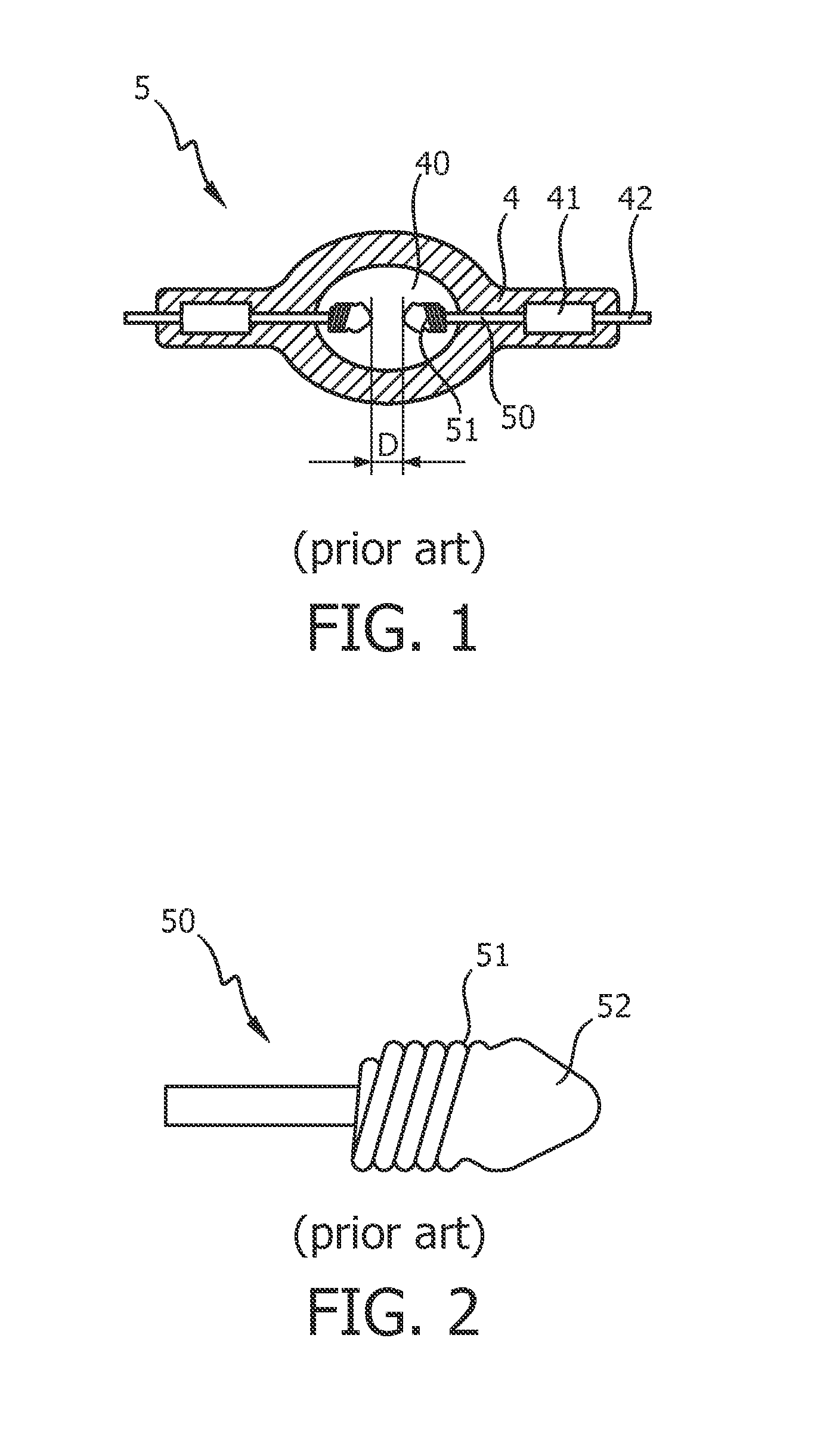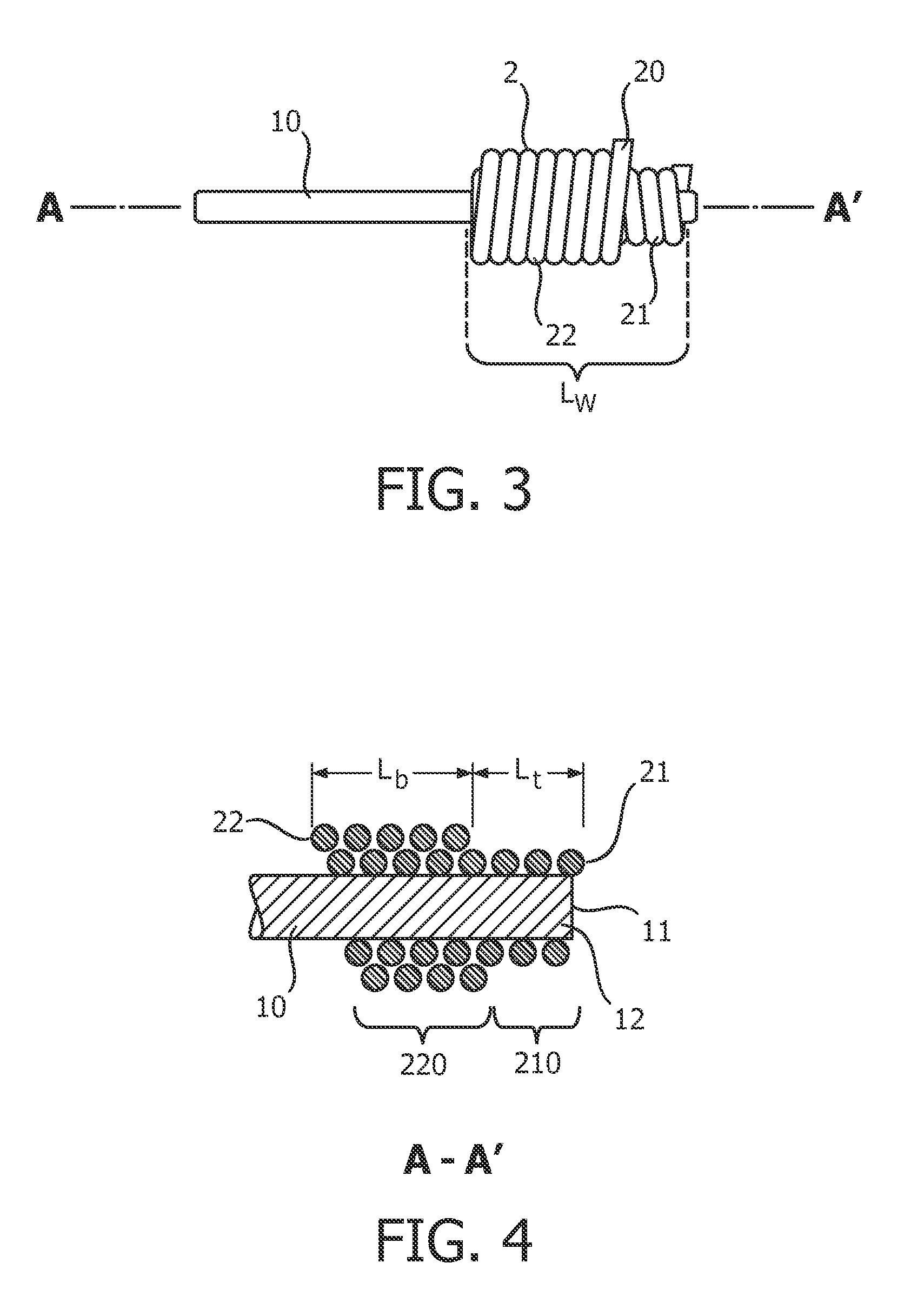[0010]An advantage of the method according to the invention is that the mass and thermal behaviour of the electrode thus manufactured are somewhere between the mass and thermal behaviour of a solid electrode design and a prior art coil-and-rod electrode design, so that the inventive electrode combines the advantages of these designs. The electrode thus manufactured is mechanically stronger than a prior art coil-and-rod electrode, and its coil can still behave as an efficient thermal radiator while the likelihood of coil breakage or opening is drastically reduced. Furthermore, the improved behaviour under high thermal load offered by the additional solid mass of the one-piece shell means that the electrode manufactured using the method according to the invention does not suffer from pronounced geometrical changes due to thermal load to the same extent as an electrode manufactured using a prior art technique. Therefore, using the method according to the invention, a favourably stable electrode with a prolonged lifetime can be manufactured in a particularly straightforward manner. The ‘one-piece shell’ is to be understood to comprise a fused portion with an uninterrupted transition to the mantle portion, even if the fused portion and mantle portion are created in separate process steps, as will be explained below. To all intents and purposes, the one-piece shell is to be regarded as a single entity. The term ‘fused portion’ is to be understood to mean re-solidified material of the electrode tip and the coil winding which has coalesced or combined during melting. The term ‘mantle portion over a remainder of the winding length’ is to be interpreted to mean that the mantle portion of the one-piece shell can extend from the fused portion to the end of the coil located towards the base of the electrode, but need not extend all the way to the end of the coil. For example, the mantle portion could terminate at a slight distance inward from the end of the coil.
[0014]The gas-discharge lamp according to the invention exhibits an improved behaviour compared to prior art gas-discharge lamps, since the inventive electrodes are not subject to extreme deformation, i.e. the electrodes maintain their shape better. The resulting favourably short and stable arc gives an advantageously point-like source of light essentially over the lifetime of the lamp, unlike prior art lamps, in which the luminance of the arc decreases over time as the electrode separation increases as a result of the alteration in electrode shape during burn-back. The stability of the electrodes also means that the lamp according to the invention exhibits favourable lamp voltage maintenance over its lifetime.
[0017]Preferably, the first coil region comprises a portion of the coil arranged around a tip of the electrode, and the first melting step comprises melting material of the first coil region and material of the electrode tip such that the melted material of the coil in the first coil region coalesces or combines with the melted material of the electrode tip to give the fused portion of the one-piece shell. This fused portion allows the electrode tip to behave in a very favourable manner during operation, since a melting back of the electrode is largely prevented, thus effectively allowing the electrode to maintain its shape over the lifetime of the lamp, without any severe geometrical distortion.
[0020]Any suitable technique of applying heat to melt the coil and electrode material could be used to shape the one-piece shell. However, in a particularly preferred embodiment of the invention, the step of melting material of the coil comprises directing a beam of laser light at the coil. In this way, energy can be deposited very precisely, to precisely chosen depths in the material of the coil and / or electrode, in order to melt only desired regions of the coil and / or electrode.
[0023]In the fused portion of the one-piece shell, the coil winding structure is no longer present, so that energy can only be radiated away from the electrode from the outer surface of the shell. Therefore, in a particularly preferred embodiment of the invention, the coil winding comprises an inner coil layer and at least one outer coil layer, and the mantle portion of the one-piece shell comprises a re-solidified outer coil layer. In this way, an inner coil layer underneath the mantle can still act to draw heat away from the electrode body and therefore also from the tip of the electrode, while the outer mantle ensures an improved mechanical performance under thermal load. Of course, the coil winding can comprises two, three or even more inner coil layers.
[0026]The luminous flux and the luminance of a discharge arc established between the front faces of two opposing electrodes will depend on the distance between the front faces. Therefore, in a particularly preferred embodiment of the invention, a separation between a front face of the first electrode and a front face of the second electrode can be in a range between 0.7 mm and 1.6 mm, depending on the optical characteristics of the lighting assembly or lighting system in which the lamp is to be used. Generally, in a gas-discharge lamp according to the invention, the electrodes can be positioned closer to each other, for example with an electrode separation of about 80% of the electrode separation in a comparable prior art lamp, so that a shorter arc with a correspondingly higher luminance can be established. The collection efficiency of the gas-discharge lamp according to the invention, i.e. the ratio of luminous flux collected through an aperture to the total luminous flux of the lamp can be favourably increased in the region of about 10 percent compared to a gas-discharge lamp with prior art electrodes.
 Login to View More
Login to View More 


